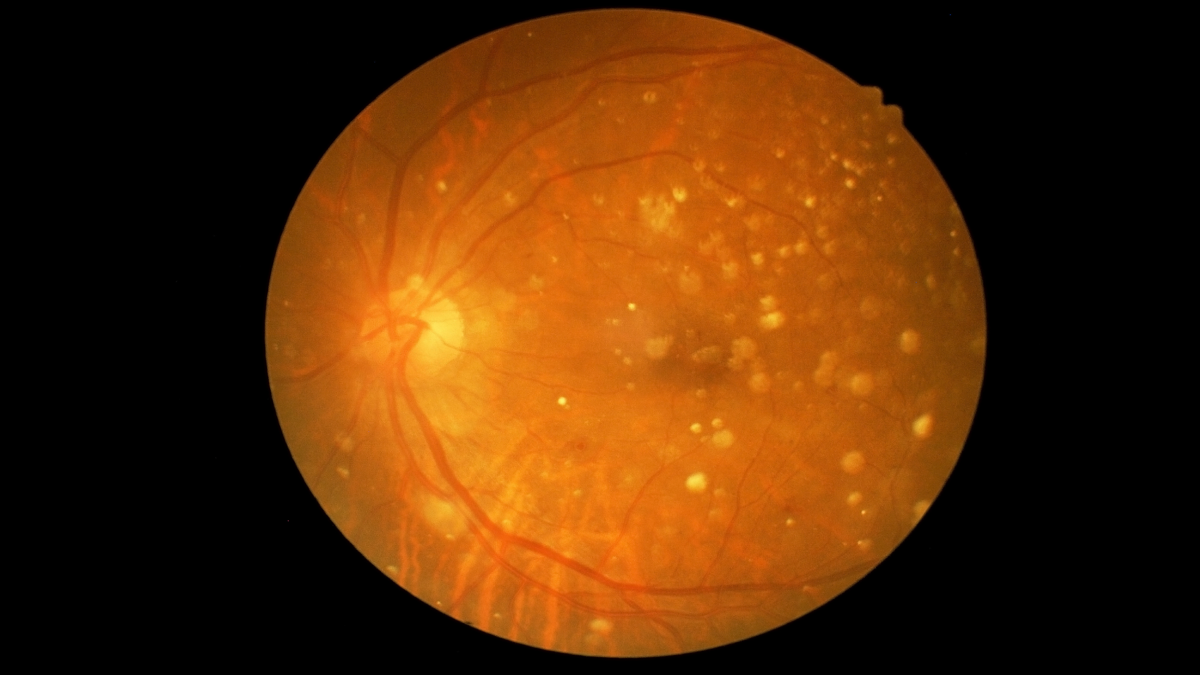Macular Degeneration Facts & Figures
Advanced age-related macular degeneration (AMD) is a leading cause of irreversible blindness and visual impairment. Nearly 20 million U.S. adults are living with some form of age-related macular degeneration.

Macular degeneration can be very serious.
- Age-related macular degeneration is an irreversible destruction of the macula, which leads to loss of the sharp, fine-detail, “straight ahead” vision required for activities like reading, driving, recognizing faces, and seeing the world in color.
- Macular degeneration is the leading cause of vision loss in Americans aged 65 and older.2
- Advanced age-related macular degeneration is a leading cause of irreversible blindness and visual impairment in the world.
Macular degeneration is widespread.
- Nearly 20 million U.S. adults have some form of age-related macular degeneration.3
- An estimated 18 million people aged 40 and older were living with early-stage macular degeneration in 2019, and 1.49 million people had late-stage macular degeneration.3
- Around 200 million people worldwide are thought to be living with AMD, a number expected to reach 288 million by 2040.7
- Age is a prominent risk factor for age-related macular degeneration. The risk of developing advanced age-related macular degeneration increases from 2% for those ages 50-59 to nearly 30% for those over the age of 75.4
Macular degeneration is expensive, and will only become more costly as the population aged 65 and older increases.
- Estimates of the global cost of visual impairment due to AMD are $343 billion, including $255 billion in direct healthcare costs.
- Estimates of the direct health care costs of visual impairment due to AMD in the U.S., Canada, and Cuba, collectively, is approximately US$98 billion.
- The global cost of vision loss due to all causes is estimated to be nearly $3 trillion for the 733 million people living with low vision and blindness worldwide. In North America alone, the direct cost of vision loss due to all causes was $512.8 billion, and the indirect costs were $179 billion.5
There are two forms of macular degeneration: dry and wet.
Dry
- The dry form of macular degeneration, in which the light-sensitive cells of the macula slowly break down, is the most common type, accounting for 90% of diagnosed cases.
- Dry macular degeneration can advance and cause vision loss without turning into the wet form of the disease. However, it is also possible for early-stage dry AMD to suddenly change into the wet form.
- Some patients with macular degeneration will develop geographic atrophy, an advanced and severe form of dry macular degeneration that can lead to permanent vision loss.
- An estimated five million people worldwide have geographic atrophy, with roughly one million of them living in the U.S.8
Wet
- Wet macular degeneration accounts for approximately 10% of cases, but results in 90% of legal blindness.
- It is considered advanced macular degeneration (there is no early or intermediate stage of wet macular degeneration).
- Wet macular degeneration is always preceded by the dry form of the disease.6
An eye care professional can help diagnose macular degeneration and determine which form(s) of the disease you have.
- To help diagnose macular degeneration, an eye care professional will perform a dilated eye exam, fundoscopy, visual acuity test, and fundus photography.
- If wet age-related macular degeneration is suspected, fluorescein angiography may be performed, in which dye is used to detect leaking blood vessels. You may also be asked to look at an Amsler grid to detect changes in your vision.
Treatments are advancing.
- Vitamins can help people with dry AMD decrease their risk of losing central vision. A specific high-dose formula of antioxidant vitamins and zinc may delay or prevent intermediate macular degeneration from progressing to the advanced stage.
- The first treatments for advanced dry macular degeneration (geographic atrophy) were approved in 2023; additional promising treatments are in clinical trials.
A healthy lifestyle may help reduce the risk of developing macular degeneration.
Healthy habits improve overall health, may reduce the risk of developing AMD, and help protect remaining vision for those with AMD.
Everyone should practice these habits to support eye health:
- Maintain a healthy weight.
- Eat a varied and nutritious diet, including green leafy vegetables, yellow and orange fruit, fish, and whole grains.
- Don’t smoke.
- Maintain normal blood pressure and control other medical conditions.
- Exercise regularly.
- When outdoors, wear a hat and sunglasses with UVA and UVB protection.
Early diagnosis can protect sight.
- It’s important to get comprehensive, dilated eye exams as recommended by your eye doctor. In these exams, the pupil is dilated with eye drops to allow your eye doctor to see into the retina.
- Because some eye diseases can begin in midlife but may not noticeably affect vision until later, the American Academy of Ophthalmology recommends people age 40 and older get a baseline comprehensive eye exam, with follow-up eye exams every one or two years or as indicated by your eye doctor.
Promising research is underway.
Ongoing research is exploring environmental, genetic, and dietary factors that may contribute to macular degeneration. New treatment strategies are also being investigated, including:
- Retinal cell transplants
- Drugs to prevent or slow disease progress
- Radiation therapy
- Gene therapies
- A computer chip implanted in the retina that may help simulate vision
- Agents that will prevent new blood vessel growth under the macula
Macular Degeneration Research, a BrightFocus Foundation program, is a leading funder of research worldwide to better detect, prevent, and cure macular degeneration and provides expert information on this devastating disease.
Related Resources
Related Resources & Information

Expert Information
Gene Therapy Advances in Age-Related Macular Degeneration
Gene therapy treatments may one day free people with age-related macular degeneration (AMD) from the need for frequent eye injections.

Macular Chats
Supporting the Supporters: Care Partners in Vision Loss
In recognition of National Caregivers Month, this episode explores the vital role of those who support individuals living with vision loss—whether family members, professionals, or volunteers.

Macular Chats
Understanding Stem Cell Research for Macular Degeneration
Dr. Jeffrey Stern and Dr. Sally Temple, Principal Investigators and Co-Founders of the Neural Stem Cell Institute, will explain what stem cells are and share the latest updates from clinical trials.

Story
Finding Purpose and Community Through Supporting Research
Dave and Leanna Palmer share their commitment to supporting Macular Degeneration Research.

Downloadable Resource
Helpful Resources for Macular Degeneration Care
Resources and information that provide products, services, and other support for people with macular degeneration and their families.

Expert Information
How Retinal and Brain Implants Restore Partial Sight
Artificial vision systems utilizing these technologies show promise for individuals with profound vision loss in early trials.


